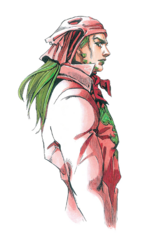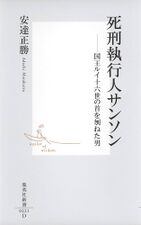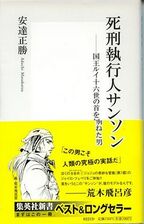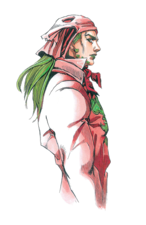Executioner Sanson: Difference between revisions
No edit summary |
|||
| Line 15: | Line 15: | ||
{{Nihongo|'''''Executioner Sanson: The Man Who Executed King Louis XVI'''''|死刑執行人サンソン 国王ルイ十六世の首を刎ねた男}} is a book written by a Japanese author {{W|安達正勝|Masakatsu Adachi|lang=ja}}. It tells the story of {{W|Charles-Henri Sanson}}, who was a French executioner responsible for the execution of King Louis XVI. |
{{Nihongo|'''''Executioner Sanson: The Man Who Executed King Louis XVI'''''|死刑執行人サンソン 国王ルイ十六世の首を刎ねた男}} is a book written by a Japanese author {{W|安達正勝|Masakatsu Adachi|lang=ja}}. It tells the story of {{W|Charles-Henri Sanson}}, who was a French executioner responsible for the execution of King Louis XVI. |
||
[[Hirohiko Araki]] reviewed the book and later stated that Sanson was the inspiration for [[Gyro Zeppeli]]. Later releases of the book were sold with an illustration of Gyro on the cover. |
[[Hirohiko Araki]] reviewed the book, and later stated that Sanson was the inspiration for [[Gyro Zeppeli]]. Later releases of the book were sold with an illustration of Gyro on the cover. |
||
==Summary== |
==Summary== |
||
Revision as of 00:01, 5 January 2025
Executioner Sanson: The Man Who Executed King Louis XVI (死刑執行人サンソン 国王ルイ十六世の首を刎ねた男) is a book written by a Japanese author Masakatsu Adachi. It tells the story of Charles-Henri Sanson, who was a French executioner responsible for the execution of King Louis XVI.
Hirohiko Araki reviewed the book, and later stated that Sanson was the inspiration for Gyro Zeppeli. Later releases of the book were sold with an illustration of Gyro on the cover.
Summary
In 2004, Hirohiko Araki published a review of Executioner Sanson in the magazine Buisness Jump.[1] In 2007, the December issue of the magazine MEN'S NON NO contained an advertisement of the book, with a statement from Araki that the Steel Ball Run character Gyro Zeppeli was inspired by Charles-Henri Sanson. It also included a drawing of Gyro in his executioner outfit.[2] Later, the book began being sold with Araki's message and the drawing on the cover.





